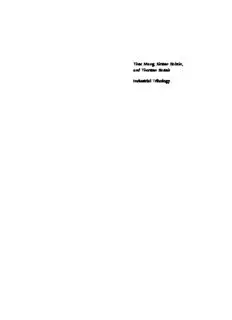
Industrial Tribology: Tribosystems, Friction, Wear and Surface Engineering, Lubrication PDF
Preview Industrial Tribology: Tribosystems, Friction, Wear and Surface Engineering, Lubrication
Theo Mang, Kirsten Bobzin, and Thorsten Bartels Industrial Tribology Related Titles Kawai, Yoshinobu/Ikegami, Hideo /Sato, Noriyoshi/Matsuda, Akihisa/ Uchino,Kiichiro /Kuzuya, Masayuki /Mizuno,Akira (eds.) Industrial Plasma Technology ApplicationsfromEnvironmentaltoEnergyTechnologies 2010 Hardcover. ISBN:978-3-527-32544-3 Fischer,Alfons/Bobzin, Kirsten (eds.) Friction, Wear and Wear Protection 2009. Hardcover. ISBN:978-3-527-32366-1 Hirt,Gerhard /Kopp, Reiner(Eds.) Thixoforming Semi-solidMetalProcessing 2009. Hardcover ISBN:978-3-527-32204-6 Khonsari, M.M.,Booser,E. R. Applied Tribology BearingDesignandLubrication Hardcover ISBN:978-0-470-05711-7 Martin, J.M.,Ohmae, N. Nanolubricants Hardcover ISBN:978-0-470-06552-5 Mang,T., Dresel,W. (eds.) Lubricants and Lubrication 2007 Hardcover ISBN:978-3-527-31497-3 Theo Mang, Kirsten Bobzin, and Thorsten Bartels Industrial Tribology Tribosystems, Friction, Wear and Surface Engineering, Lubrication TheAuthors AllbookspublishedbyWiley-VCHarecarefully produced.Nevertheless,authors,editors,and Prof.Dr.-Ing.TheoMang publisherdonotwarranttheinformationcontained Holzweg30 inthesebooks,includingthisbook,tobefreeof 69469Weinheim errors.Readersareadvisedtokeepinmindthat Germany statements,data,illustrations,proceduraldetailsor otheritemsmayinadvertentlybeinaccurate. Prof.Dr.-Ing.KirstenBobzin RWTHAachenUniversity LibraryofCongressCardNo.: appliedfor (IOT) Intzestr.10 BritishLibraryCataloguing-in-PublicationData 52072Aachen Acataloguerecordforthisbookisavailablefromthe Germany BritishLibrary. Dr.-Ing.ThorstenBartels Bibliographicinformationpublishedby RohMaxAdditivesGmbH theDeutscheNationalbibliothek Kirschenallee TheDeutscheNationalbibliothekliststhis 64293Darmstadt publicationintheDeutscheNationalbibliografie; Germany detailedbibliographicdataareavailableonthe Internetathttp://dnb.d-nb.de. #2011WILEY-VCHVerlag&Co.KGaA, Boschstr.12,69469Weinheim,Germany Allrightsreserved(includingthoseoftranslationinto otherlanguages).Nopartofthisbookmaybe reproducedinanyform–byphotoprinting, microfilm,oranyothermeans–nortransmittedor translatedintoamachinelanguagewithoutwritten permissionfromthepublishers.Registerednames, trademarks,etc.usedinthisbook,evenwhennot specificallymarkedassuch,arenottobeconsidered unprotectedbylaw. Cover Formgeber,Eppelheim Typesetting ThomsonDigital,Noida,India PrintingandBinding betz-druckGmbH,Darmstadt PrintedintheFederalRepublicofGermany Printedonacid-freepaper ISBN:978-3-527-32057-8 V Contents Preface XVII Abbreviations XIX 1 Introduction 1 1.1 TheTermTribology 1 1.2 ImportanceofTribology 2 1.3 HistoryofTribology 2 1.3.1 TheIndustrialRevolution 5 1.3.2 Between1850and1945 5 1.3.3 From1950tothePresentDay 6 References 7 2 TheTribologicalSystem 9 2.1 TribologicalSurfaces 12 2.2 WettingofSolidSurfaces 17 2.3 TriboContactSurfaces 19 2.4 TribologicalLoading 21 References 23 3 Friction 25 3.1 KineticandStaticFriction 25 3.2 CoefficientofFriction 26 3.3 Stick-Slip 26 3.4 SlidingandRollingFriction 27 3.5 FrictionRegimes:FrictionandLubricationConditions 28 3.5.1 SolidFriction(DryFriction) 28 3.5.2 BoundaryFriction 29 3.5.3 FluidFilmFriction 30 3.5.4 MixedFriction 30 3.5.5 StribeckCurve 31 3.6 HydrodynamicandElastohydrodynamicLubrication 32 IndustrialTribology:Tribosystems,Friction,WearandSurfaceEngineering,Lubrication TheoMang,KirstenBobzin,andThorstenBartels Copyright(cid:1)2011WILEY-VCHVerlagGmbH&Co.KGaA,Weinheim ISBN:978-3-527-32057-8 VI Contents 3.6.1 ElastohydrodynamicLubrication(EHL)Regime 32 3.6.2 ThermoelastohydrodynamicLubrication(TEHL) 35 3.6.3 PlastohydrodynamicLubrication 36 References 36 4 Wear 37 4.1 WearMechanisms 38 4.1.1 Adhesion 38 4.1.2 TribochemicalReactions 40 4.1.3 Abrasion 41 4.1.4 SurfaceFatigue 42 4.2 TypesofWear 44 4.3 WearParameters 44 References 47 5 TribologicalMaterials 49 5.1 BasicPrinciplesofMaterialsScience 52 5.1.1 InfluencingtheStrengthProperties 52 5.1.2 InfluencingtheMaterialBehavioratHigherTemperatures 56 5.1.2.1 Diffusion 56 5.1.2.2 Recovery,Recrystallization,andGrainGrowth 57 5.1.2.3 CreepandStressRelaxation 57 5.1.2.4 HighTemperatureStrength 59 5.2 MetallicMaterials 60 5.2.1 LightweightMetals 61 5.2.1.1 AluminumandAluminumAlloys 61 5.2.1.2 MagnesiumandMagnesiumAlloys 65 5.2.1.3 TitaniumandTitaniumAlloys 68 5.2.2 CopperandCopperAlloys 70 5.2.3 IronandIronAlloys 71 5.2.3.1 CastIron 74 5.2.3.2 Steel 75 5.2.4 HardAlloys 80 5.2.5 Super-Alloys 83 5.2.6 RefractoryMetals 87 5.2.7 Intermetallics 88 5.3 Non-MetallicInorganicMaterials 91 5.3.1 StructureofHardMaterials 91 5.3.2 EngineeringCeramics 93 5.3.2.1 OxideCeramics 94 5.3.2.2 Non-OxideCeramics 94 5.3.2.3 SilicateCeramics 95 5.4 OrganicMaterials 95 5.4.1 Thermoplasts 98 5.4.2 Duroplasts 99 Contents VII 5.4.3 Elastomers 99 5.5 CompositeMaterials 100 5.5.1 PolymerMatrixComposites(PMC) 103 5.5.2 CeramicMatrixComposites(CMCs) 103 5.5.3 MetalMatrixComposites(MMCs) 104 5.5.3.1 MMCsforLightweightConstructions 104 5.5.3.2 MMCsforMaximumWearResistance 106 References 109 6 SurfaceEngineering 113 6.1 IntroductiontoSurfaceEngineering 115 6.1.1 MethodicalApproachforCoatingDevelopment 116 6.1.2 BondingMechanisms 117 6.1.2.1 MechanicalClamping 119 6.1.2.2 Diffusion 119 6.1.2.3 Pseudo-Diffusion 120 6.1.2.4 Adhesion 120 6.1.2.5 ChemicalBonding 120 6.2 ProcessesofSurfaceEngineering 120 6.2.1 ConvertingProcesses 122 6.2.1.1 Anodizing 124 6.2.1.2 Phosphatizing 129 6.2.1.3 Chromatizing 133 6.2.1.4 ComparisonofChromatizingandPhosphatizing 136 6.2.1.5 Burnishing 137 6.2.2 PhysicalVaporDeposition(PVD) 138 6.2.2.1 GenerationofaGaseousPhaseorPlasma 139 6.2.2.2 ParticleTransport 142 6.2.2.3 Condensation,LayerGrowth 144 6.2.2.4 PVDProcessTechnology 146 6.2.2.5 PVDToolCoating 152 6.2.2.6 PVDComponentCoating 153 6.2.3 ChemicalVaporDeposition(CVD) 155 6.2.3.1 ThermodynamicsoftheChemicalReaction 158 6.2.3.2 ReactionChemistry 160 6.2.3.3 CoatingDepositionKinetics 162 6.2.3.4 CVDProcesses 165 6.2.3.5 CVDToolCoating 170 6.2.3.6 CVDComponentCoating 172 6.2.4 Sol–GelDeposition 173 6.2.4.1 TheSolasStartingMaterial 175 6.2.4.2 TheSol–GelTransition 175 6.2.4.3 Wet-ChemicalSynthesisSystems 175 6.2.4.4 CoatingsWiththeSol–GelProcess 177 6.2.4.5 ExamplesofApplicationsforSol–GelCoatings 179 VIII Contents 6.2.5 ElectrochemicalMetalDeposition 180 6.2.5.1 ThermodynamicPrinciplesofElectrochemistry 182 6.2.5.2 KineticPrinciplesofElectrochemistry 188 6.2.5.3 Electroplating 191 6.2.5.4 ChemicalDeposition 194 6.2.5.5 CoatingSystemsforElectrochemicalMetalDeposition 197 6.2.6 ThermalSpraying 203 6.2.6.1 PrincipleofThermalSprayingProcesses 204 6.2.6.2 FormationofCoatingswithThermalSpraying 206 6.2.6.3 BondingofThermalSprayingCoatings 208 6.2.6.4 ThermalSprayingProcesses 210 6.2.6.5 CoatingMaterialsandExamplesofThermalSprayingApplications 223 6.2.7 DepositionWelding 225 6.2.7.1 MaterialCompositesProducedbyDepositionwelding 227 6.2.7.2 DepositionweldingProcesses 227 6.2.7.3 CoatingMaterialsandExamplesofApplicationsforDeposition welding 232 6.2.8 Brazing 234 6.2.8.1 PrinciplesofBrazing 235 6.2.8.2 ClassificationofBrazingProcessesandFillerMetals 238 6.2.8.3 DepositionBrazingofHardMaterial–FillerMetal CompositeSystems 242 6.2.8.4 ApplicationofArmoringbyBrazing 247 6.2.9 Thermo-ChemicalDiffusionTreatment 251 6.2.9.1 PrinciplesofDiffusion 253 6.2.9.2 Carburizing 257 6.2.9.3 Nitriding 260 6.2.9.4 Nitro-Carburizing 267 6.2.9.5 Boriding 269 6.2.9.6 Chromizing 271 References 274 7 Lubricants 281 7.1 LubricantsandtheirMarket 281 7.2 MineralBaseOils 284 7.2.1 BaseOils:AHistoricalReviewandOutlook 285 7.2.2 ChemicalCharacterizationofMineralBaseOils 285 7.2.2.1 CarbonDistribution 286 7.2.2.2 HydrocarbonComposition 286 7.2.2.3 PolycyclicAromaticsinBaseOils 286 7.2.3 Refining 288 7.2.3.1 Distillation 288 7.2.3.2 De-Asphalting 289 7.2.3.3 TraditionalRefiningProcesses 290 7.2.4 BaseOilManufacturingbyHydrogenationandHydrocracking 293 Contents IX 7.2.4.1 LubeHydrocracking 294 7.2.4.2 CatalyticDewaxing 295 7.2.4.3 WaxIsomerization 296 7.2.4.4 HybridLubeOilProcessing 296 7.2.4.5 TheAll-HydrogenRoute 296 7.2.4.6 Gas-to-LiquidsConversionTechnology 297 7.2.4.7 BreakdownoftheBaseoilMarket 298 7.2.5 BoilingandEvaporationBehaviorofBaseOils 298 7.2.6 OtherPhysical–ChemicalPropertiesofBaseOils 300 7.2.6.1 ThermalVolume-ExpansionCoefficient 300 7.2.6.2 Compressibility 301 7.2.6.3 GasSolubility 301 7.2.7 BaseOilCategoriesandEvaluationofVariousPetroleumBaseOils 302 7.3 SyntheticBaseOils 303 7.3.1 Polyalphaolefins 304 7.3.2 Polybutenes 305 7.3.3 AlkylatedAromatics 305 7.3.4 SyntheticEsters 306 7.3.4.1 EstersofCarboxylicAcids 306 7.3.4.2 DicarboxylicAcidEsters 306 7.3.4.3 PolyolEsters 307 7.3.4.4 OtherCarboxylicEsters 307 7.3.4.5 DimericAcidEsters 307 7.3.4.6 ComplexEsters 308 7.3.4.7 PhosphateEsters 308 7.3.5 PolyalkyleneGlycols 308 7.3.6 PerfluorinatedPolyethers 310 7.3.7 Polysiloxanes(SiliconeOils) 310 7.4 RheologyofLubricants 311 7.4.1 Viscosity 311 7.4.2 InfluenceofTemperatureonViscosity(V–TBehavior) 313 7.4.2.1 ViscosityIndex 314 7.4.3 Viscosity–PressureDependency 315 7.4.4 TheEffectofShearRateonViscosity 317 7.4.5 SpecialRheologicalEffects 317 7.4.5.1 Greases 318 7.4.6 ViscosityGrades 318 7.4.6.1 ISOViscosityGrades 319 7.4.6.2 EngineOils 319 7.4.6.3 AutomotiveGearOils 319 7.4.6.4 IndustrialGearOils 319 7.4.6.5 BaseOils 319 7.5 Additives 320 7.5.1 Antioxidants 321 7.5.1.1 PhenolicAntioxidants 322 X Contents 7.5.1.2 AromaticAmines 322 7.5.1.3 CompoundsContainingSulfurandPhosphorus 322 7.5.1.4 OrganosulfurCompounds 322 7.5.1.5 OrganophosphorusCompounds 323 7.5.1.6 SynergisticMixtures 323 7.5.1.7 TestingtheOxidationStability 323 7.5.2 ViscosityModifiers 323 7.5.3 PourpointDepressants 324 7.5.4 DetergentsandDispersants 326 7.5.4.1 Phenates 327 7.5.4.2 Salicylates 327 7.5.4.3 Thiophosphonates 327 7.5.4.4 Sulfonates 327 7.5.4.5 AshlessDispersants 328 7.5.5 AntifoamAgents 328 7.5.5.1 SiliconDefoamers 329 7.5.5.2 Silicone-FreeDefoamers 329 7.5.6 DemulsifiersandEmulsifiers 329 7.5.6.1 Demulsifiers 329 7.5.6.2 Emulsifiers 329 7.5.7 Antiwear(AW)andExtremePressure(EP)Additives 330 7.5.7.1 PhosphorusCompounds 330 7.5.7.2 CompoundsContainingSulfurandPhosphorus 331 7.5.7.3 CompoundsContainingSulfurandNitrogen 331 7.5.7.4 SulfurCompounds 331 7.5.7.5 ChlorineCompounds 332 7.5.7.6 SolidLubricatingCompounds 333 7.5.8 FrictionModifiers(FMs) 333 7.5.9 CorrosionInhibitors 333 7.5.9.1 AntirustAdditives(FerrousMetals) 334 7.5.9.2 MetalPassivators(NonferrousMetals) 335 7.6 LubricantsforInternalCombustionEngines 335 7.6.1 FunctionofEngineOilsinFour-StrokeEngines 336 7.6.2 ViscosityGrades 337 7.6.3 PerformanceSpecifications 337 7.6.4 FormulationofEngineOils 337 7.6.5 EngineOilTesting 338 7.6.6 PassengerCarEngineOils 339 7.6.7 EngineOilforCommercialVehicles 339 7.6.8 ClassificationandSpecification 339 7.6.8.1 MILSpecifications 339 7.6.8.2 APIandILSACClassifications 340 7.6.8.3 ACEASpecifications 340 7.6.9 FutureTrends(seealsoSection8.5.8) 343 7.6.10 FuelEfficiency 343
